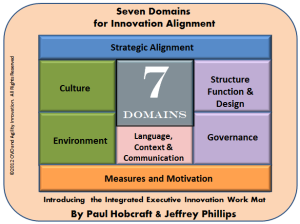All too often strategy is not influencing the behaviours and outcomes around innovation, it is simply allowing them to be left to chance.
Innovation is often being pushed down the organization for others to interpret and offer their answers. This lack of alignment and top leadership engagement is one of the main causes why many organizations seem to just simply ‘limp’ along in their innovation activity.
Then those in leadership positions start expressing their disappointment over final innovation results, yet the answers simply lies more often than not as in their hands to resolve. Top leadership in organizations needs to shape innovation and be more involved in its strategic design.
We need to resolve this innovation leadership gap of misunderstanding. We need to explain what their essential place is and provide the strategic frame to allow it to be understood. Then the contribution for innovation might be ‘allowed’ to deliver far more on its potential as it achieves that greater strategic alignment. Continue reading “The weak influence of strategy over our innovation activities”

